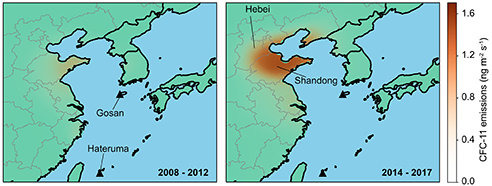Mysterious Ozone-Depleting CFC Emissions Source Finally Discovered
Around this time last year, a study was published revealing that at least one entity somewhere in the world was likely engaging in the production of a banned ozone-depleting chlorofluorocarbon gas called CFC-11. Scientists had discovered that CFC-11 levels were rising despite its ban in 2010, indicating that it was still being used somewhere in the world, though no one could definitely point toward the source at that time.READ: Study: banned ozone-destroying gas may still be in production
Now, just over a year after that study's publication, new research has revealed the likely source of those emissions. According to the University of Bristol, a team of international scientists have used global monitoring networks, including the NOAA Global Monitoring Division and AGAGE, to narrow the emissions source down to eastern China, specifically the Hebei and Shandong provinces.
The use of CFC-11 began to phase out in 2010 under the Montreal Protocol. As revealed last year, however, emissions levels starting increasing around 2013, slowing down the ozone layer's recovery time. Part of the source had previously been narrowed down to somewhere in eastern Asia, but no additional details had been available.

An AGAGE station located in South Korea helped narrow down the emissions source, as well as an affiliate station operated by the NIES in Japan. Professor Sunyoung Park from South Korea's Kyungpook National University explained:
Our measurements show 'spikes' in pollution, when air arrives from industrialised areas. For CFC-11, we noticed that the magnitude of these spikes increased after 2012, indicating that emissions must have grown from somewhere in the region.
Ultimately, it took the collective effort of scientists around the world to determine that CFC-11 emissions out of eastern China had increased by approximately 7,000 tons annually after 2012, with Hebei and Shandong both being the epicenters of this output. No other countries monitored by these networks demonstrated any increased CFC-11 emissions, according to the announcement.
Existing foam insulations used in refrigerators and buildings before 2010 aren't sufficient enough to explain the increase. All signs point toward new production driving the increase, but additional work is necessary to determine which industries are producing the emissions.
Of particular concern is what products are being created that are linked to this output — the scientists warn that if the production involves the creation of new foams and similar products intended for elsewhere, such as in refrigerators and new buildings, it could result in increased CFC-11 emissions over multiple future decades, stalling ozone layer recovery efforts.
